Brian Meert's Blog, page 104
October 16, 2018
How to Spot a Fake Instagram Influencer
 October 16, 2018
October 16, 2018Rachel Horvath, guest writer at AdvertiseMint, Facebook advertising agency
 Elijah O’Donnell
Elijah O’DonnellInstagram influencers are a billion dollar industry, so it’s no wonder that fake influencers are popping up to score a quick buck. While hiring an influencer can be important for promoting products, it’s also key to know how to identify a fake influencer.
What Are Influencers and Why Are They Important?
On Instagram, an influencer is a person with tons of followers and engagement. An influencer can sign with a company that wants to promote a product, service, or business, and the influencer gets paid to do so. It can be a smart idea to align your company with an influencer who can make an impact with your target audience. Hiring an influencer is an authentic way to help your customers learn about what you have to offer and raise awareness of your brand.
Influencers spend a lot of time and effort building their audience and establishing credibility, and their audience trusts them to give helpful and informative advice. Instagram has over a billion active monthly users, so influencers can reach a large number of people with their posts. Hiring an influencer can make an impact on your business, but before you sign a contract, you have to make sure that the influencer you’re looking at is legit.
Identify a Fake Influencer
 Phil Desforges
Phil DesforgesInfluencers have a huge amount of pull in the social media world, so it’s only natural that people will try to cash in on the trend. It’s very easy and inexpensive to buy followers and likes on Instagram. An inexperienced marketer might fall for the trap and sign a contract with influencers who bought all of their likes and follows. It’s important to learn how to spot a fake influencer lest you fall into the same trap.
Engagement Ratio
An important first step is to check their engagement to following ratio. If they have a huge number of followers but their posts don’t have much engagement, this is a red flag. You want to know that an influencer influences, i.e. sparks discussions and gets people talking. Check out a few of their posts and look for meaningful comments, not just “great post” or “I like this!” Simple comments like this can come from bots, which aren’t real profiles. If you see a profile with thousands of followers, but the profile hardly gets any likes or comments on posts, take heed. In 2017, the median engagement rate on Instagram was 2.7 percent. If you notice engagement lower than that, the profile might not be legit.
Do Some Research
You can also snoop on Google. Type in the influencer’s name and see what else comes up. If you come back with zero search results, this is a warning sign of a faker. But if you see the influencer also has a following on Facebook, YouTube, or Twitter, the influencer is likely legitimate. Additionally, if the influencer interacts with other influencers on Instagram and other social media sites, it can be a sure sign of authenticity, too.
Look for Interaction
Great influencers interact with their audience as much as possible. Do the influencers respond to comments on their posts? Are they getting involved in discussions and talking to people? A fake or bot account won’t have this type of engagement, so you need to keep an eye on this.
Instagram is a powerful tool for marketers, and hiring an influencer can be a great idea. But make sure you’re on the lookout for fake accounts before you hire an influencer!
Written by Rachel Horvath, guest writer at AdvertiseMint, Facebook advertising agency
The post How to Spot a Fake Instagram Influencer appeared first on AdvertiseMint.
October 15, 2018
Snapchat to Release Original Scripted Content Beginning This Month
 October 15, 2018
October 15, 2018Andrea Francese, guest writer at AdvertiseMint, company for Facebook ads

Snap Inc., the social media platform based out of Venice, California, is entering the scripted content market. On October 10th the company released a statement that revealed 12 new scripted Snapchat shows. While the platform has offered show type content for over two years, this is the company’s first foray into scripted content.
The original content will launch in October of 2018. The shows, designed around 8 to 12 episodes, will release daily until the story is complete. Snapchat is aiming for a staggered release model, with three shows launching together. The company hopes the staggered release will move the audience from one show directly into the next Snap Original.
According to company insiders, the originally scripted content will span a variety of different genres. The first of the Snap Originals will explore the horror, comedy, drama, docu-series and mystery genres. If all goes well with the scripted content, the company will expand into additional genres, including animation and romance. Additional scripted series are believed to be in the pipeline.
Snapchat has released information about all 12 shows that will appear on the platform. First to be released are Endless Summer, a docu-series that follows the lives of a couple in Laguna Beach. It will release at the same time as Class of Lies, a mystery show following a team solving a friend’s disappearance, and Co-Ed, a college comedy following freshman roommates navigating the unfamiliar waters of campus life.
Vivian, a series that follows a scout at the Wilhelmina modeling agency will be released on October 22nd. Dead Girls Detective Agency, a supernatural soap opera, and V/H/S, a horror anthology, will follow. Snapchat is also slated to release Bref, Bringing up Bhabie, Growing Up Is Drag, Stunt Brothers, Deep Creek, and #Vanlife later this year.
To achieve the scripted originals, Snapchat has teamed up with from Friday Night Lights and Bunim/Murray Productions, the company that conceptualized Keeping up With the Kardashians. Both Harris and Bunim/Murray are well known for their ability to craft unique content that engages a broad demographic of viewers.
The news couldn’t come as a more opportune time for the social media platform. Snapchat lost $353 million last quarter, as it struggled to compete with social media conglomerates Instagram and Facebook. While growth stagnated on the platform, in general, one area of the discover page did offer a glimmer of hope.
Growth across the Snapchat shows suggested the company could grow if it redirected focus to content that is created for the platform. The company currently offers 18 shows that receive more than 10 million unique viewers each month. Currently, the platform provides shows from Viacom, CBS, and the NFL, among others.
Using the show format also allows the company to find new streams of advertising revenue, which has long been a roadblock for the company. The company hopes the scripted content will not only build a larger user base but also entice advertisers to buy ad space in the form of non-skippable commercials inserted into each episode.
Time will only tell whether or not Snapchat is onto something big with its exploration into the scripted genre, but if all goes well, it is possible mobile users will have an entirely new and unique way of consuming content and of entertaining themselves from the privacy of their phone. As it stands, however, users will get to see the 12 shows already slated. More may be forthcoming.
Written by Andrea Francese, guest writer at AdvertiseMint, company for Facebook ads
The post Snapchat to Release Original Scripted Content Beginning This Month appeared first on AdvertiseMint.
October 12, 2018
4 Ways to Easily Improve Your Facebook Ad Campaigns
 October 13, 2018
October 13, 2018Rachel Horvath, guest writer at AdvertiseMint, Facebook ads company

Facebook ads are a great way to reach your target audience quickly and effectively. When advertising on Facebook, though, you want to make sure you’re getting the best return on investment. Technology and trends change quickly, so read on to make sure you’re on top of Facebook advertising and to learn how to improve your ad campaigns.
1. Optimize Your Bids
When you think about improving our Facebook ads, we often jump to the conclusion that we need to change the format of the ad, the text, or the audience. While this often reaps great results, there are other factors at play. If you want a leg up on competitors, it’s not just about having a great design and catchy text. Even the best ad campaign can be ruined with a poor bidding strategy.
When you’re running an ad campaign, you’re competing with hundreds of thousands of other advertisers for ad real estate. Ad space is limited, so the highest bidder gets the most ad space. You can choose to use Facebook’s automatic bidding settings, or you can choose your own, which gives you more control over your budget. If your ads just aren’t working with Facebook’s automatic settings, you can manually choose from three settings:
Lowest cost will get you as many placements as possible at the lowest cost.
Lowest cost with a cap is similar to the above option, but you can choose the maximum you’re willing to pay
Target cost lets you set an average cost to spend per bid. Facebook may go above or below this cost, as long as the average cost stays at what you set.
2. Try Split Testing
Split testing can be a great tool to find out what works best for your ads. To split test, run two ads that are different in one crucial way. For example, you may test two different ads with two different images or videos or test an image ad against a video ad. You may even target your ads at two different audiences. Let the campaign run for a while, and then compare the results. See which ad gets more engagement. If it’s clear that one target audience responds more than another, or that video engages your audience more than an image, or that certain words in your text inspire a greater reaction, then you can create better, more effective ads using that knowledge.
3. Use GIFs

Sometimes static images or texts don’t do the job. Facebook allowed the use of GIFs in ads last winter. If you don’t think your audience has the patience to get through a video, or you don’t think video is necessary to show off your product or service, a GIF can be an eye-catching way to do so. Additionally, unlike videos, GIFs don’t require too much time and effort to make, so they are a quick and easy way to boost your ad
4. Give Video a Try

If you have a bit of wiggle room in your advertising budget, video can be an extremely effective tool. People retain much more of what they see in video than print, so it’s great for capturing and engaging audiences. Great videos tell a story and speak to people’s emotions, so keep it short, simple, and powerful. If you’re going to use video, however, it’s important to make sure it looks great. Poor quality video can really turn potential customers off, so create a video with great lighting and stellar sound. Although you can shoot video on a cell phone, it might be best to look into a professional company to make a great video for you.
Stay ahead of the Facebook ad curve by trying these strategies!
Written by Rachel Horvath, guest writer at AdvertiseMint, Facebook ads company
The post 4 Ways to Easily Improve Your Facebook Ad Campaigns appeared first on AdvertiseMint.
October 11, 2018
These 5 Food Brands’ Effective Social Media Posts Will Make Your Mouth Water
 October 11, 2018
October 11, 2018Anna Hubbel, writer at AdvertiseMint, Facebook ad agency
 Gabriela Rodríguez / Unsplash
Gabriela Rodríguez / UnsplashI am not ashamed of my love for food. That love is only enhanced by images and videos I come across on my social media feeds. Bread seems fluffier, soda looks bubblier, and ice cream appears smoother. It’s an absolute pleasure for my senses.
Posts by food brands that appeal to the senses, that makes your mouth water, trigger hunger and encourage people to go out, buy the product, and eat it. I can’t tell you the number of times I’ve made a special trip to the nearest gas station to buy a cold bottle of Coke after seeing an ad for it.
I’m not the only one making a trip to the store in pursuit of a delicious product. According to Emarketer, 96 percent of US internet users prefer to shop for food and beverages in-store because they want to see the quality of the product in person. By effectively marketing food and beverage products on social media, brands can influence consumers’ appetites, can influence them to go out and feed their hungers.
There are a few specific food brands I like to follow on social media because they’re so effective at appealing to my senses. In this article, I will talk about my favorite food brands’ best social media posts and why they’re effective. I challenge your mouth not to water while you read.
Coca-Cola
Nothing says “drink me” like a tall bottle of ice cold Coca-Cola. While the product sells itself (a static image of a Coke can do it for me), the brand incorporates current events to keep the brand relevant to users.
In this Facebook post, Coca-Cola mentions the FIFA World Cup Final in the post text, tying the social event to the beverage brand with the word “Cheers.” The post’s message is clear: celebrate with a bottle of coke.

In another example, Coca-Cola ties its brand to Thanksgiving. In the video, a family shares a Thanksgiving feast, which includes a giant turkey and bottles of Coke.

Both posts show the product, a glass bottle of Coke, in relevant social settings while also making the beverage look tempting, with sparkles through the glass and condensation dripping along the edges.
Dairy Queen
Dairy Queen presents its popular Blizzard ice cream treats in a fun way that appeals to our inner child. In this Facebook post, Dairy Queen playfully features its fall Blizzard flavors from an overhead view against a bright blue background so you can see the textures, colors, and toppings. You can’t help but get the urge to go out and treat yo’self to a sugary ice-cream delight.
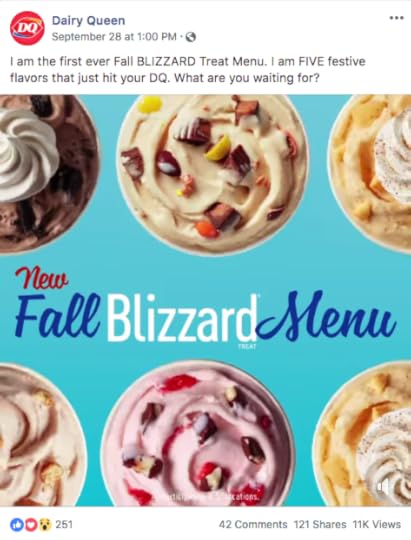
In this short Instagram video, Dairy Queen promotes its pumpkin pie Blizzard flavor. It contrasts the product with pumpkin pie, switching between the two desserts so you associate the favorite fall flavor with the product. Dairy Queen recognizes consumers’ current taste for the fall season and taps into those taste buds to get you to indulge in its seasonal flavors.

Panera Bread
Panera Bread features close-ups of its dishes so you can see the colors and textures in such detail that your mouth starts to water. This Facebook close-up of Panera’s mac-and-cheese bread bowl shows the cheesiness of the pasta and the crinkle of the bread. You half expect the spoon to jump straight from the screen to your mouth. When it doesn’t, you consider grabbing your keys and making it happen.

In another post, Panera shows off fresh ingredients in this particular close-up. The bright greens and reds are the main focal points of the image, which are colors we typically associate with the word “fresh.” Looking at it, you can almost feel the crunch of the lettuce between your teeth.

Oreo
Oreo knows that most people who think of children and milk and cookies think of its product. That’s why the brand uses those associations on its social media posts. Oreo uses a cartoon animation in a Facebook post to promote its Halloween cookies. It’s creative and relevant while also making the product the focus.
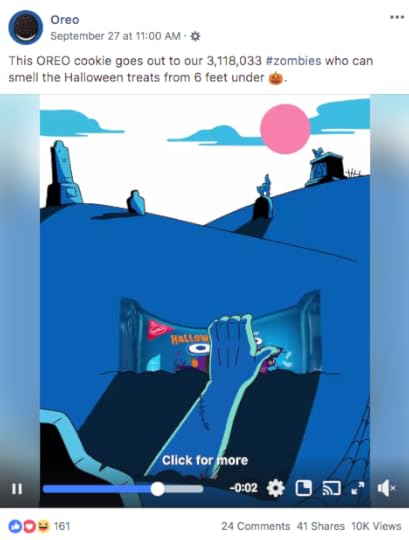
The simple pairing of one Oreo cookie with a glass of milk effectively evokes the taste of milk and cookies in this Instagram video. When played, the video is primarily static aside from the milk swishing in the glass. The use of the blue background references the brand colors while also allows the milk and cookies to pop. Who wants some milk and cookies? I do!
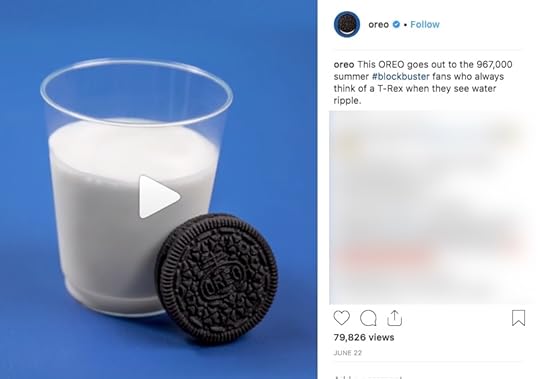
Blue Apron
While most food brands only have one product to highlight, Blue Apron has the unique challenge of promoting its food choices. The food delivery brand accomplishes this by featuring one of its many meals and listing the variety of fresh ingredients that go into the meals. Matching the recipe with a colorful image of the dish gets you thinking about dinner. Adding the “20 minutes” value proposition makes this post extra effective.

Blue Apron again describes the ingredients in this Instagram video, but this time it adds the pop-culture reference, Bob’s Burgers, to feature this particular burger recipe. Not only can you imagine the taste of the burger, but you can also imagine eating it in a Bob’s Burgers setting. Both imaginings are positive, influencing your decision to subscribe to Blue Apron.
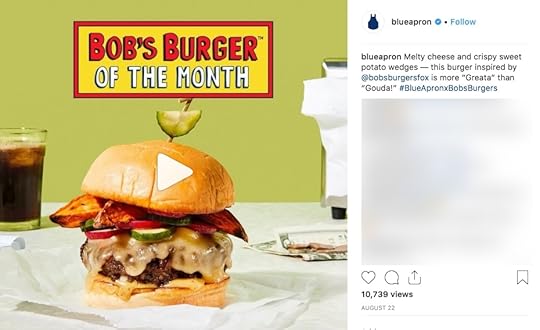
These social media posts are a few good examples of how brands strategically, creatively, and effectively appeal to consumers’ appetites, turning them into loyal customers. I bet your mouth couldn’t help but water while examining those posts.
Written by Anna Hubbel, writer at AdvertiseMint, Facebook ad agency
The post These 5 Food Brands’ Effective Social Media Posts Will Make Your Mouth Water appeared first on AdvertiseMint.
October 10, 2018
A Look inside US Shoppers’ Buying Journeys
 October 10, 2018
October 10, 2018Anna Hubbel, writer at AdvertiseMint, Facebook ad agency
 Andrew Le / Unsplash
Andrew Le / UnsplashWhat is the thought process of the average US shopper? Amazon wanted to answer this question to help brands better understand their audiences. Working with global measurement firm comScore, Amazon gathered in-depth insight about consumers who use the e-commerce platform for their shopping needs.
In a blog post the company shared recently, Amazon’s Dave Martin talks about the findings from comScore’s study of 609 US shoppers. In the study conducted via survey in April 2018, the participants were asked questions about their purchase of televisions within the last six months. Specifically, the study sought to learn the shoppers’ research methods, the important factors in their decision processes, and the channels they primarily used for their research.
The study unveiled three major findings:
Shoppers took their time and turned to multiple sources.
Shoppers researched multiple brands and reviews on Amazon.
Most shoppers made their final purchases in-store.
Here’s an in-depth look at each of these findings.
Shoppers Took Their Time and Turned to Multiple Sources

Shoppers in the study took their time to research before making the purchase. The shoppers didn’t purchase impulsively. Fifty-six percent of the participants researched their purchases for over one week. The time frame may be because the products the participants wanted to buy was expensive. Forty percent said they spent over $1,000 on their final purchase. They did their research to make sure they would not have buyer’s remorse.
The research involved multiple visits online or in-store, which were a big part of the participants’ shopping journey. Participants indicated that they visited an average of 3.9 retailers or retailer websites when looking for televisions. Seventy-six percent of the shoppers looked both online and offline. Sixty-two percent said they eventually bought their television at a physical store.
Shoppers Researched Multiple Brands and Reviews on Amazon
Unsurprisingly, shoppers used Amazon to aid them in their television research. Throughout their research, shoppers looked at multiple brands and customer reviews to determine product quality and durability. They also referred to the product pages to learn about the features of the televisions and compared prices between products and brands.
The study uncovered several statistics surrounding the use of Amazon as a research tool. According to Amazon, the shoppers visited the Amazon website or app an average of six times before making a purchase. During those visits, they researched an average total of 2.8 brands and read an average of 9.6 customer reviews throughout their shopping journey. Additionally, 65 percent of the study’s participants indicated that Amazon was their top choice for comparing prices between different models and brands.
Most Shoppers Made Their Final Purchases In-Store

As previously mentioned, 62 percent of shoppers said they bought their televisions in physical stores. However, while at the store where they bought their televisions, about two-thirds of the shoppers researched features, price comparisons, and customer reviews on their smartphones. Thirty-one percent of the 64 percent that did researched customer reviews to inform their purchase. Additionally, previous Amazon users who bought their televisions in-store used the site an average of 5.3 times to research the product before buying it.
Amazon Is a Big Part of Shoppers’ Buying Journeys
According to Amazon, the findings from this study show that the Amazon site is useful to customers, even to offline shoppers.
“Amazon is an important part of customer’s shopping journey across physical and online retailers, regardless of where the final purchases take place,” says Martin. “This is especially true for high-consideration items like TVs. Shoppers take their time and utilize Amazon for brand and product details and customer reviews, both online when they are starting the process and in store prior to completing a purchase.”
To help brands engage with shoppers throughout their shopping journey, Amazon recommends using Sponsored Products and Sponsored Brands, two of its ad formats, to drive product research and reach shoppers when they’re active on Amazon. Additionally, brands should remarket to audiences who have already visited their product detail page to tap into their interest in the product.
US shoppers trust Amazon, whether it’s to buy an item directly through the site or research a product to inform an in-store purchase. Brands can build trust with customers by reaching shoppers through the dependable site. They just need to know their audience and understand their shopping journeys.
Written by Anna Hubbel, writer at AdvertiseMint, Facebook ad agency
The post A Look inside US Shoppers’ Buying Journeys appeared first on AdvertiseMint.
October 9, 2018
New Instagram Stories Feature Lets You Post Multiple Stories at Once
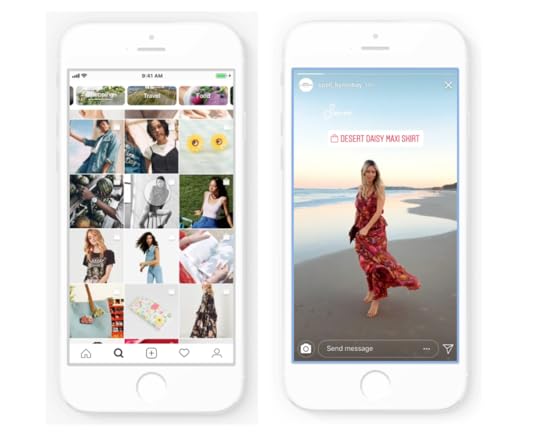 October 9, 2018
October 9, 2018Anne Felicitas, editor at AdvertiseMint, Facebook advertising agency

Instagram Stories, as fun as it is, can be a little inconvenient at times. If you want to record a scene that lasts longer than Instagram’s 15-second limit, you would need to record multiple 15-second videos, posting them separately. That will change for everyone soon.
 Instagram’s new multiple stories feature
Instagram’s new multiple stories featureToday, a feature that allows you to record multiple stories at once appears on Instagram. When you hold the capture button, multiple 15-second stories will record. The fully recorded 15-second stories will appear on your screen while you continue filming. You can record up to 10 stories at once. Once finished, you can post your stories either to your feed or as a private message to friends.
The best part? The feature works for the hands-free mode.
Not everyone has the update, so it’s either a test or a slow rollout. If it’s a test, let’s hope it rolls out officially—it makes Instagram Stories a more seamless experience.
Written by Anne Felicitas, editor at AdvertiseMint, Facebook advertising agency
The post New Instagram Stories Feature Lets You Post Multiple Stories at Once appeared first on AdvertiseMint.
New to Facebook: Ads That Click to WhatsApp
 October 9, 2018
October 9, 2018By Anna Hubbel, writer at AdvertiseMint, Facebook ads company

Facebook announced that all advertisers globally can now use ads users can click to open a chat in WhatsApp. Advertisers can access the new capability in Ads Manager. The update helps boost business exposure on WhatsApp.
How It Works
With this update, advertisers can create a News Feed ad with a call-to-action button users can select to open a WhatsApp chat with the business. When the chat opens, it displays a default message users can edit to their liking before sending to the business, establishing a WhatsApp relationship.
The call-to-action button appears at the bottom right of the ad creative, similar to the call-to-action ads can include to open a Facebook Messenger chat. The option can be found under the Messages objective in Ads Manager.
To create ads that direct users to WhatsApp, advertisers must have both a WhatsApp Business account and a Facebook Ads Manager account. The business’s WhatsApp account must also be connected to Ads Manager, which can be done under “Message Destination” in Ads Manager.
The Benefits
WhatsApp makes it easier for users to communicate with businesses, without the hassle of a phone call, through instant messaging and calling. A business with a WhatsApp Business app has access to multimedia messaging, free calls, free international messaging, and group chats, as well as customizable quick replies and user statistics. The new call-to-action that can direct users from News Feed to WhatsApp makes businesses more discoverable and accessible in a seamless experience.
With more than 300 million daily active users, WhatsApp also gives businesses a massive customer base to reach.
Written by Anna Hubbel, writer at AdvertiseMint, Facebook ads company
The post New to Facebook: Ads That Click to WhatsApp appeared first on AdvertiseMint.
New to Facebook: A First-Party Cookie Option with Facebook Pixel
 October 9, 2018
October 9, 2018Anna Hubbel, writer at AdvertiseMint, Facebook ads company

Recently, Facebook announced in an email that advertisers will receive a first-party cookie option for Facebook Pixel starting October 24. Up until this point, advertisers could only use third-party cookies with the pixel to acquire information for website analytics, ad targeting, and ad measurement.
Using the first-party option, in addition to the benefits of third-party cookies, advertisers, publishers, and developers can gather even more refined analytics related to their website traffic. First-party cookies are directly owned by the website a user is navigating at the moment, whereas third-party cookies are owned by a separate website. The new option will help advertisers learn more about audience behaviors in relation to their site and ultimately allow them to produce even more relevant ads.
In the email announcement, Facebook explained that it’s offering the new option because first-party cookies are becoming the preferable choice for browsers and other online platforms. Cookies are the advertiser’s key to serving relevant ads and understanding audiences. Offering first-party cookies is the next logical step.
If advertisers do not want to run with the first-party option, they can update their pixel settings in Events Manager.
What Is Facebook Pixel?
Facebook Pixel is a snippet of code that advertisers can use to collect data about their audiences for their advertising campaigns. The code is simply added to the backend of a website, allowing the pixel to generate signals about the website activity of both new and existing customers. Facebook Pixel is particularly helpful in engaging with audiences using relevant messages.
How the Update Affects Users
Facebook said users will continue to maintain the same control over which ads they see on Facebook using Ads Preferences. Additionally, businesses will still need to be fully transparent about their use of cookies and third-party (and first-party) data collection as stipulated in Facebook’s Business Tools Terms. All of Facebook’s rules about full transparency will still apply.
Why So Transparent
From clearly labeling electoral and issue ads to requiring page verification to adding an Info and Ads tab to all pages, Facebook has been rolling out a gamut of transparency measures. The company dived head-on into reactive and proactive mode after the Cambridge Analytica scandal, in which the data firm deceptively collected user information to distribute politically motivated messages during the 2016 US Presidential Election. Add that to the Russian troll accounts that sent out divisive ads during the same election, Facebook was facing a lot of heat. Understandably, the company has been updating its expectations of advertisers as of late to ensure more positive experiences for users.
It isn’t just Facebook who has been holding advertisers to higher standards, however. According to a recent study, 81 percent of consumers believe brands should be transparent on social media. Additionally, the study found that only 71 percent of users hold themselves to the same standard of social media transparency.
Advertisers will be able to reap the full benefits of the first-party cookie option as long as they also adhere to Facebook’s transparency requirements.
Written by Anna Hubbel, writer at AdvertiseMint, Facebook ads company
The post New to Facebook: A First-Party Cookie Option with Facebook Pixel appeared first on AdvertiseMint.
According to Studies, Consumers Hold Brands to a Higher Standard of Transparency
 October 9, 2018
October 9, 2018Anna Hubbel, writer at AdvertiseMint, Facebook ads company

It turns out that consumers want you to give it to them straight. A recent study found that consumers expect brands to be transparent on social media. Study participants said that brands have more responsibility to be open and honest than anyone else on social platforms.
A Sprout Social study found that 81 percent of consumers believe brands must be transparent on social media, according to the Emarketer article. The term “transparency” encompasses the characteristics of honesty, openness, clarity, and authenticity. Interestingly, only 71 percent of consumers hold themselves to the same standard, and only 57 percent said they also expect celebrities to be transparent.
According to the study, participants considered withholding information, ignoring customer questions, and ignoring employee questions as lack of transparency. More than 34 percent said dodging political or social issues also indicates a lack of transparency.
Topics participants want brands to be transparent about are the following:
Product/service changes: 53 percent
Company values: 53 percent
Business practices: 50 percent
Company policy changes: 49 percent
Employment practices: 46 percent
Pricing decisions: 43 percent
Marketing practices: 41 percent
Diversity and inclusion: 40 percent
Financial performance: 38 percent
Additional findings showed that consumers believe
A brand’s social media candor can positively influence future purchases: 53 percent
A brand’s social media candor can influence purchase frequency: 37 percent
They’d recommend a transparent brand to family and friends: 42 percent
These findings indicate that consumers see social media as a major representation of brands. So much so, in fact, that they believe brands should be beacons of transparency over individual users. It all boils down to trust. The more open and honest a brand, the more consumers are likely to trust it. Since brands are seen as incentivized by money, consumers want to know for certain that they can be trusted before buying from brands.
Transparency vs. Product Quality
 Unsplash / Rawpixel
Unsplash / RawpixelDespite the weight consumers place on transparency in this particular study, Emarketer says other studies suggest an attitude-behavior gap. Specifically, although consumers expect brands to be transparent at all times, product quality and cost are ultimately the biggest influences in purchase decisions. A Cone Communications and Porter Novelli survey revealed that 41 percent of participants considered product quality to be the primary influence in their purchase decisions. Thirty-nine percent said cost was the leading factor. Similarly, in a Morning Consult survey, 90 percent of the Millennial respondents said price and quality were top influencing factors.
Taking these conflicting findings into consideration, you may wonder where you should primarily focus your energy when maintaining your brand presence on social media. The answer is simple: offer high-quality products at decent prices while being fully transparent. In other words, focusing on product quality and price should not negate transparency. They are not mutually exclusive. It’s that simple.
You also want to take into account the ways social media platforms are increasing their measures to ensure brand transparency. For example, Facebook now offers an Info and Ads tab on business pages that allows users to view every active ad the page has published. Additionally, all electoral or issue ads are now labeled “Political Ad.” These types of measures help prevent platform abuse while also improving the overall user experience. If you fail to comply with a platform’s transparency measures, you are not going to fair well with your target audiences.
Don’t let the dog-eat-dog world of advertising get in the way of your ethics and integrity. If the people want transparency from your brand, there’s nothing to suggest they shouldn’t get it. To ensure you’re being fully transparent on social media, diligently manage your social media accounts so you don’t run the risk of becoming negligent. Otherwise, consumers may call you out on it.
Written by Anna Hubbel, writer at AdvertiseMint, Facebook ads company
The post According to Studies, Consumers Hold Brands to a Higher Standard of Transparency appeared first on AdvertiseMint.
October 8, 2018
How to Organically Improve Your App Store Optimization
 October 8, 2018
October 8, 2018Anna Hubbel, writer at AdvertiseMint, Facebook advertising agency

Both the Apple App Store and the Google Play Store are highly competitive spaces where app developers struggle to stand out against competitors. According to Statista, the Apple store has more than two million apps and Google Play Store has 3.6 million apps. In both stores, app developers face the massive task of attracting users to not only click but to also download.
As a result of this app battleground, developers often turn to paid advertising to market their app within either app store. However, that can be expensive. What other alternative do you have, since organic reach is nearly impossible in such a competitive space?
Emarketer says there’s a disciplinary practice all app developers should be familiar with: app store optimization (ASO). This practice involves optimizing your app’s core assets. Core assets include your app’s icon (i.e. the main app visual that appears on users phones once they’ve downloaded your app), title, and description. By focusing on your ASO, according to Emarketer, you can organically market your app without dishing out the dollars on app store ads.
ASO Tips
Here are a few tips to help you improve your app store optimization and to make your app more visible and discoverable in any mobile app store.
Create short, searchable titles: Because both Apple and Google stipulate a maximum number of characters for your app’s title, create a title that succinctly describes your app’s purpose but also includes relevant keywords that will boost it in search.
Inform users in your description: Include in your description the information you were unable to convey in your app title. Avoid jamming too much in your description because the description will primarily appeal to crawler bots rather than users. Use a balance of good copywriting and relevant keywords to accurately describe your app’s functionality.
Regularly update your keywords: To keep your app refreshed in search results, update the keywords within your app description regularly. You still want the keywords to be relevant, but a regular refresh helps prevent your app’s search visibility from going dry.
Offer incentives for ratings: When you’ve built up somewhat of a customer base, offer users who like your app incentives in exchange for rating your app. Positive ratings help boost your ASO, which increases the number of users who download your app, which also helps ASO (and the cycle goes round and round).
Make your app icon appealing. It’s very important to make your app’s icon look good because it’s the first thing users see. A boring icon won’t stand out, which means fewer clicks, fewer downloads, and overall poor ASO.
Pick the right category. Last but not least, place your app in the most relevant category. Consider your app’s functionality to figure out which category is best. If there is more than one category that’s relevant, Up Tech recommends looking at the number of competing apps already in each category and then choosing whichever one has the fewest number of apps.
The Importance of Improving Your Visibility in App Stores
A 2017 survey by Button and App Annie found that most US smartphone users find or install new apps through either the Apple App Store or the Google Play Store. It came out on top of other sources at 59 percent, followed by trusted sources (20 percent). Clearly, your app stands a better chance at achieving downloads through marketing in either one of the two app stores than any other source.
App marketing success comes down to the users who visit an app store to download an app. The challenge is attracting their eyes and enticing them to download your app. Don’t forget the answer to increasing visibility: ASO.
Written by Anna Hubbel, writer at AdvertiseMint, Facebook advertising agency
The post How to Organically Improve Your App Store Optimization appeared first on AdvertiseMint.



